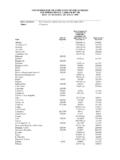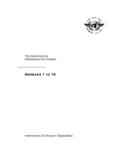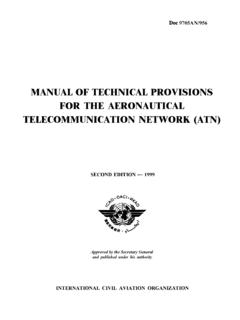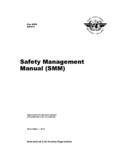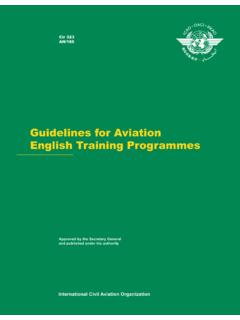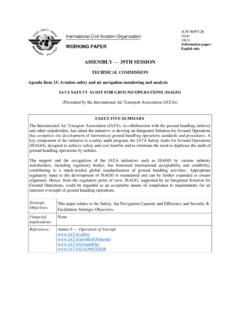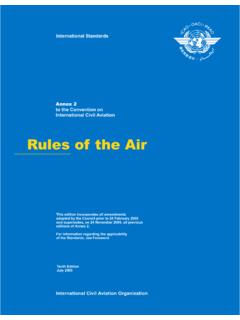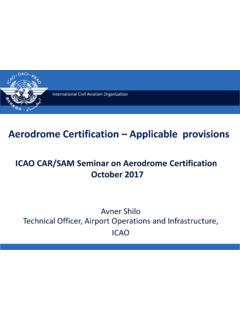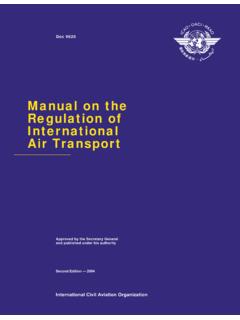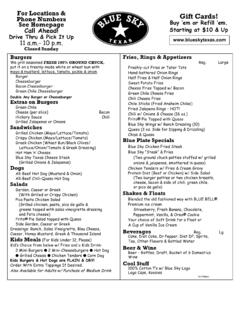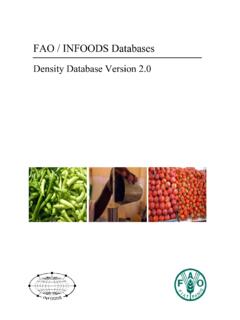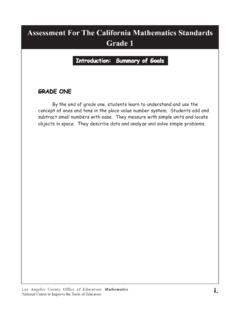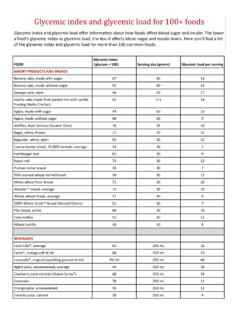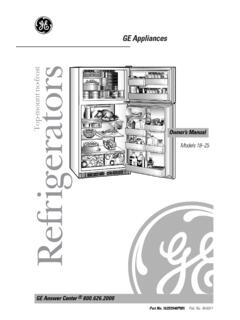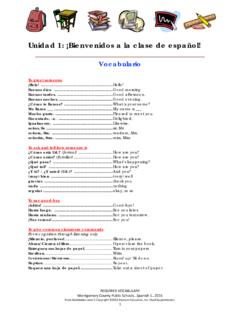Transcription of Appendix on Dangerous Goods - ICAO
1 AppDG-1 Appendix on Dangerous Goods 1. Certain articles or substances are classified as Dangerous Goods by the ICAO Technical Instructions for the Safe Transport of Dangerous Goods by Air. The Technical Instructions list over 3 000 Dangerous Goods , and with the exception of a small number of permitted items, Dangerous Goods must not be carried by passengers on their person or in their or carry-on baggage or hold Although the primary task of personnel carrying out the duties of airport security screeners will be the detection of prohibited items, they also have a role to play in the safety of aviation by detecting Dangerous Goods in passengers cabin and hold baggage.
2 3. Examples of forbidden Dangerous Goods are as follows: Forbidden Substances Example Explosives Grenades, fireworks, flares Gases Propane, butane Flammable liquids Gasoline, methanol Flammable solids and reactive substances Magnesium, firelighters Oxidizers/organic peroxides Bleach, car body repair kits Toxic/infectious substances Rat poison, infected blood Radioactive material Medicinal or commercial isotopes Corrosives Mercury, vehicle batteries Miscellaneous Vehicle fuel system components which have contained fuel Dangerous Goods carried by passengers or crew ICAO Technical Instructions 8; Except as otherwise provided in [the ICAO TI s Part 8] Dangerous Goods must not be carried by passengers or crew members, either as carry-on baggage or checked baggage or on their person.
3 Security type equipment such as attach cases, cash boxes, cash bags, etc. incorporating Dangerous Goods , for example lithium batteries or pyrotechnic material, are totally (extract from the 2001-2002 edition of the ICAO Technical Instructions).4. A list of permitted Dangerous Goods and items which may be carried by passengers, under certain conditions, is reproduced in Attachment A to this Appendix . This should be used only as a guide to what is permitted and forbidden in passenger or crew baggage. Dangerous Goods not contained in the list are forbidden and must not be carried on the UNDECLARED Dangerous Goods 5. When a screener discovers an item that is believed to be Dangerous Goods which are not permitted for carriage by passengers but have not been declared by the passenger, this must be referred to supervisory staff.
4 (The depth of training of screeners should be commensurate with the responsibilities of the staff.) If suspicions remain or it is confirmed that the item is not permitted, the operator must be notified for DGP-WG/06-WP/50 Appendix BAppDG-2 Security Manual further action, and the item must not be allowed to be loaded on the aircraft. (Additionally, the ICAO Technical Instructions require that when Dangerous Goods not permitted for carriage are discovered in a passenger s baggage, the aircraft operator must notify the appropriate authority of the State in which the item was discovered.) IDENTIFICATION OF Dangerous Goods 6.
5 There are two primary tools that can be used to help identify the presence of Dangerous Goods : x Markingon the packaging of the proper shipping name, the class number or numbers and/or a unique four-digit United Nations number ( Gasoline, Class 3, UN 1203). x Labels designed to correspond to the classes and divisions of Dangerous Goods . (See Attachment B.) CARRIAGE OF CERTAIN Dangerous Goods 7. Provisions exist for the carriage of certain Dangerous Goods after precautions have been taken with regard to the physical handling and proper marking and labelling of the item. For example provisions exist for spillable batteries, which have been removed from a wheelchair or mobility aid accompanying a passenger, to be carried as checked hold baggage.
6 The batteries must be packed in accordance with specified procedures, and packages must be marked Battery, wet, with wheelchair , or Battery, wet, with mobility aid . They must bear a corrosive hazard warning label and a package orientation label. No other spillable batteries are permitted in a passenger s hold baggage. LEAKAGE OR DAMAGE 8. Certain basic actions must be taken when discovering leakage or damage of suspected Dangerous Goods . These include: x avoid contact with item; x isolate the immediate area; x advise supervisory staff who should notify the operator and the aerodrome authority; x attempt to determine from the passenger the nature of the item; x if necessary, notify emergency services; x notify the aircraft operator.
7 Note. This order may change depending on local rules and procedures. REFERENCES FOR FURTHER INFORMATION 9. The current editions of: x ICAOT echnical Instructions for the Safe Transport of Dangerous Goods by Air(Doc 9284); DGP-WG/06-WP/50 Appendix BB-2 Appendix on Dangerous Goods AppDG-3 x IATA Dangerous Goods Regulations. AID TO THE RECOGNITION OF Dangerous Goods Dangerous Goods in household items 10. Many common items used every day in the bathroom, kitchen, garage or at work may seem harmless, however, due to their physical and chemical properties they can be very Dangerous when transported by air.
8 Check-in staff and security screeners should seek confirmation from a passenger about the contents of any item where there are suspicions that it may contain Dangerous Goods . The following common articles or substances may contain Dangerous Goods : x Breathing apparatus May indicate cylinders of compressed air or oxygen, chemical oxygen generators or refrigerated liquefied oxygen. x Camping equipment May contain flammable gases (butane, propane, etc.), flammable liquids (kerosene, gasoline, etc.), or flammable solids (hexamine, matches, etc.). x Chemicals May contain items meeting any of the criteria for Dangerous Goods , particularly flammable liquids, flammable solids, oxidizers, organic peroxides, toxic or corrosive substances.
9 X Frozen fruit, vegetables, etc. May be packed in dry ice (solid carbon dioxide). x Household Goods May contain items meeting any of the criteria for Dangerous Goods . Examples include flammable liquids such as solvent-based paint, adhesives, polishes, aerosols, bleach, corrosive oven or drain cleaners, ammunition, matches, etc. x Passenger s baggage May contain items meeting any of the criteria for Dangerous Goods . Examples include fireworks, flammable household liquids, corrosive oven or drain cleaners, flammable gas or liquid lighter refills or camping stove cylinders, matches, ammunition, bleach, aerosols, etc.
10 X Refrigerators May contain liquefied gases or an ammonia solution. x Swimming pool chemicals May contain oxidizing or corrosive substances. Equipment, instruments and tool boxes x Automobile parts (car, motor, motorcycle) May include engines, carburettors or fuel tanks that contain or have contained fuel, wet batteries, compressed gases in tire inflation devices and fire extinguishers, air bags, etc. x Gas cylinders May contain compressed or liquefied gases. x Diving equipment May contain cylinders of compressed gas ( air or oxygen). May also contain high intensity diving lamps that can generate extreme heat when operated in air.
